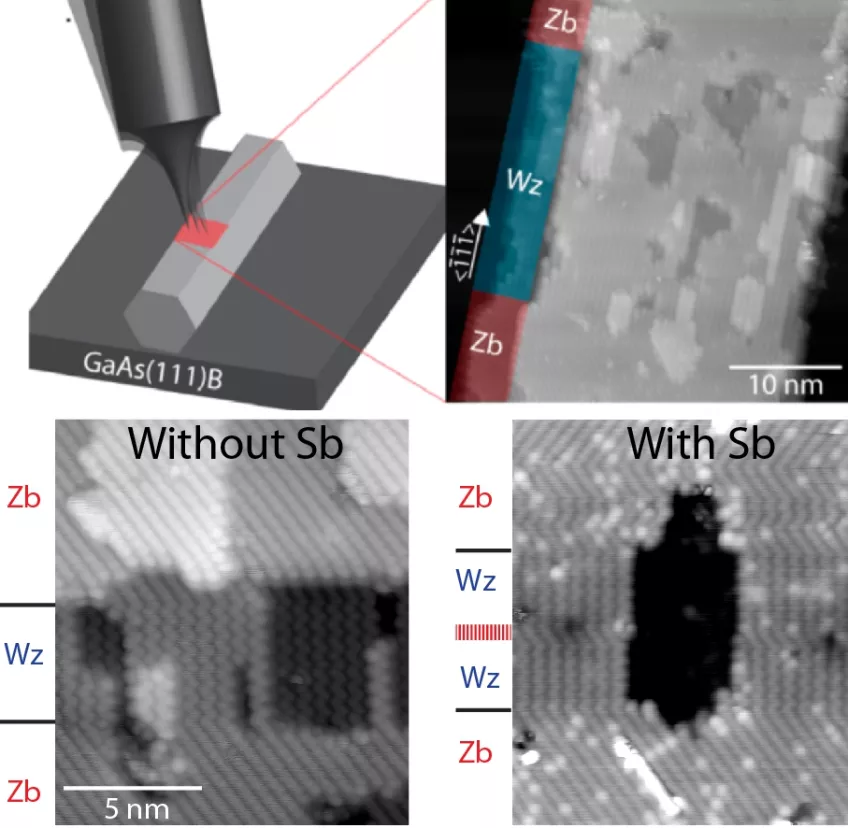PhD project: surfaces at the atomic scale
Structure, function, and modification of semiconductor nanostructure surfaces to the atomic scale
With the continuous downscaling of nanostructure devices, surface effects become more and more dominating. Characterization and controlled modification of surfaces at the atomic scale gets essential, though challenging. Direct access to electronic and geometric surface structure with atomic resolution is available uniquely by Scanning Tunneling Microscopy and Spectroscopy (STM/S). Furthermore, we can bridge the gap between surface characterization of ideal model surfaces and device processing, by investigating semiconductor nanostructures during device operation, using our newly developed STM/S platform for operando surface studies. Complementary chemical information is obtained from X-ray spectroscopy and imaging studies at MAX IV and other synchrotron facilities.
Introduction
The Department of Physics is with a staff of about 350 scientists and educators one of the largest departments within Lund University. There are seven research divisions and a number of research centra within the department. The research activities at the department cover a broad spectrum of modern physics.
The Department of Physics
The Division of Synchrotron Radiation Research (www.sljus.lu.se) is a part of the Physics Department, with about 50 employees. The main focus of the research is experimental studies of electronic, structural, and chemical properties of materials, especially nanostructures. At the division we use and develop a wide range of synchrotron and lab based techniques, such as X-ray photoelectron spectroscopy/imaging and X-ray diffraction/imaging. We also host Sweden's largest facility for scanning probe microscopy.
Division of Synchrotron Radiation Research
Lund University Scanning Probe Microscopy Facility (LUSP)
MAX IV is a national large-scale research laboratory hosted by Lund University and situated within biking distance from the Department of Physics. It provides scientists from Sweden and the rest of the world with the most brilliant Synchrotron radiation source and instrumentation for research in areas such as materials science and nanotechnology.
Website of MAX IV
See Rainer Timm's page for information about the main supervisor of the project
Project specification
Work duties
The aim of this project is to study technologically relevant semiconductor nanostructures and to obtain an as complete understanding of their surfaces as possible. This includes structural, electronic, and chemical information at the atomic scale, obtained even during device operation or surface modification. Nanowires developed at NanoLund and intended for application in photovoltaics or electronics will be in the centre of investigation, but other nanostructure surfaces will be studied as well.
Within this project, the PhD candidate will use scanning probe microscopy – including both scanning tunneling microscopy (STM) and atomic force microscopy (AFM) – to investigate various properties of nanostructure surfaces and interfaces down to the atomic scale. Complementary experimental techniques include photoemission spectroscopy, under vacuum conditions or even at ambient pressure for monitoring surface chemical reactions, and X-ray diffraction and imaging.
The research group has access to three dedicated AFM setups and to five fully functioning ultrahigh vacuum STM/AFM systems, including a newly acquired low-temperature STM/AFM for measurements at 10K. Several of the STMs are equipped with electrical contacts for in-situ studies of electronic devices. In addition, experiments will be performed at the MAX IV Laboratory in Lund, as well as at other international synchrotron and scanning probe facilities. Finally, experiments will include the use of a variety of other widely used nanoscience characterization and fabrication techniques. The project will also include a secondment at a company or a research institution in Sweden or abroad.
The successful candidate is expected to use existing equipment and develop novel approaches to explore nanostructure surfaces and devices, even under operational conditions or during surface functionalization. The work will be performed in collaboration with several other researchers at the institute.
The main duties of doctoral students are to devote themselves to their research studies which includes participating in research projects and third cycle courses. The work duties can also include teaching and other departmental duties (no more than 20%).
Desirable skills
For the present position, experience with high resolution AFM or STM or surface studies of semiconductors is important. The ability for skilful laboratory work is essential, including advanced microscopy and ultrahigh vacuum technology. Experience in working at synchrotron radiation facilities is of additional benefit. Experience in the scientific interaction with researchers from other disciplines and from other countries is considered as valuable.
Enrolment: Physics, Science Faculty
Supervisors
Supervisors for this project will be Rainer Timm and Anders Mikkelsen.
Rainer Timm, Senior lecturer at Synchrotron Radiation Research
Anders Mikkelsen, Prof. at Synchrotron Radiation Research and Vice-Director of NanoLund
Positions in the 2nd call
The call was open from 25 June to 25 August 2020. Six PhD students were recruited, among them five are eligible for GenerationNano funding. Three of the GenerationNano students have recently started their employment and the two remaining will start soon.


